A Wideband Magneto-Electric (ME) Dipole Antenna Enabled by ME Resonance and Aperture-Coupled Excitation
Abstract
1. Introduction
2. Materials and Methods
2.1. Antenna Geometry
2.2. Design Process of the Proposed Antenna
2.3. ME Resonant Mode Analysis
2.4. ME Resonant Modes: RLC Equivalent Circuit
3. Results
4. Discussion
5. Conclusions
Author Contributions
Funding
Data Availability Statement
Conflicts of Interest
References
- Hong, W.; Jiang, Z.H.; Yu, C.; Hou, D.; Wang, H.; Guo, C.; Hu, Y.; Kuai, L.; Yu, Y.; Jiang, Z.; et al. The Role of Millimeter-Wave Technologies in 5G/6G Wireless Communications. IEEE J. Microw. 2021, 1, 101–122. [Google Scholar] [CrossRef]
- Wong, K.L.; Shaw, C.H.; Li, W.T.; Li, W.Y. Ultra-Wideband On-Metal Four-Antenna Module for 5G/6G/WiFi-6E IoT Mobile Device MIMO Antennas and Its Field Test Study. IEEE Access 2024, 12, 166349–166367. [Google Scholar] [CrossRef]
- Suresh, A.C.; Reddy, T.S.; Madhav, B.T.P.; Alshathri, S.; El-Shafai, W.; Das, S.; Sorathiya, V. A Novel Design of Spike-Shaped Miniaturized 4 × 4 MIMO Antenna for Wireless UWB Network Applications Using Characteristic Mode Analysis. Micromachines 2023, 14, 612. [Google Scholar] [CrossRef]
- Sarin, V.P.; Nishamol, M.S.; Tony, D.; Aanandan, C.K.; Mohanan, P.; Vasudevan, K. A Wideband Stacked Offset Microstrip Antenna with Improved Gain and Low Cross Polarization. IEEE Trans. Antennas Propag. 2011, 59, 1376–1379. [Google Scholar] [CrossRef]
- Awida, M.H.; Fathy, A.E. Substrate-Integrated Waveguide Ku-Band Cavity-Backed 2 × 2 Microstrip Patch Array Antenna. IEEE Antennas Wirel. Propag. Lett. 2009, 8, 1054–1056. [Google Scholar] [CrossRef]
- Raha, K.; Ray, K.P. Broadband High Gain and Low Cross-Polarization Double Cavity-Backed Stacked Microstrip Antenna. IEEE Trans. Antennas Propag. 2022, 70, 5902–5906. [Google Scholar] [CrossRef]
- Luk, K.M.; Wong, H. A New Wideband Unidirectional Antenna Element. Int. J. Microw. Opt. Technol. 2006, 1, 35–44. [Google Scholar]
- Huang, K.; Li, X.; Zhang, Y. Circuit Analysis of a Filtering Magneto-Electric Dipole Antenna Design. In Proceedings of the 2021 International Conference on Microwave and Millimeter Wave Technology, ICMMT 2021—Proceedings, Nanjing, China, 23–26 May 2021; Institute of Electrical and Electronics Engineers Inc.: Piscataway, NJ, USA, 2021. [Google Scholar]
- Pham, D.A.; Park, E.; Lee, H.L.; Lim, S. High Gain and Wideband Metasurfaced Magnetoelectric Antenna for WiGig Applications. IEEE Trans. Antennas Propag. 2021, 69, 1140–1145. [Google Scholar] [CrossRef]
- Feng, C.-Q.; Zhang, F.-S.; Zhang, H.-J.; Su, J.-X. A Single-Feed Circularly Polarized Magnetoelectric Dipole Antenna for Wideband Wireless Applications. Prog. Electromagn. Res. M 2018, 65, 1–8. [Google Scholar] [CrossRef]
- Ashouri, M.H.; Fakhte, S.; Taskhiri, M.M. A Broadband High Gain Circularly Polarized Magneto-Electric Dipole Antenna with Chiral Metamaterial for 5G/WIMAX Wireless Network. Wirel. Netw. 2024, 30, 845–855. [Google Scholar] [CrossRef]
- Xiang, L.; Wu, F.; Xia, X.; Jiang, Z.H.; Yu, C.; Hong, W. Millimeter-Wave Wideband Dual-Polarized and Circularly-Polarized ME-Dipole Reflectarrays With Linearly Polarized Feed. IEEE Trans. Antennas Propag. 2024, 72, 8022–8027. [Google Scholar] [CrossRef]
- Ruan, X.; Ng, K.B.; Chan, C.H. A Differentially Fed Transmission-Line-Excited Magnetoelectric Dipole Antenna Array for 5G Applications. IEEE Trans. Antennas Propag. 2018, 66, 5224–5230. [Google Scholar] [CrossRef]
- Cui, X.; Yang, F.; Gao, M.; Zhou, L.; Liang, Z.; Yan, F. A Wideband Magnetoelectric Dipole Antenna with Microstrip Line Aperture-Coupled Excitation. IEEE Trans. Antennas Propag. 2017, 65, 7350–7354. [Google Scholar] [CrossRef]
- Yang, K.W.; Zhang, F.S.; Li, C.; Zhang, Z.H.; Zhang, F. A Wideband Aperture Coupled Magneto-Electric Dipole with High Gain Stability. Int. J. RF Microw. Comput.-Aided Eng. 2020, 30, e22197. [Google Scholar] [CrossRef]
- Zhao, X.; Hu, Y.; Sheng, J.; Wang, Z.; Hong, W. Wideband Antenna Based on Aperture-Coupled Magneto-Electric Dipole for Millimeter Wave Applications. In Proceedings of the 2023 IEEE MTT-S International Wireless Symposium, IWS 2023—Proceedings, Qingdao, China, 14–17 May 2023; Institute of Electrical and Electronics Engineers Inc.: Piscataway, NJ, USA, 2023. [Google Scholar]
- Sabeti, S.M.; Zehforoosh, Y.; Mohammadi, P. A Low-Profile Stacked ME Dipole Antenna Loaded with High-Permittivity Dielectric for 5G Applications. IEEE Access 2024, 12, 125544–125556. [Google Scholar] [CrossRef]
- Yang, G.; Li, J.; Yang, J.; Zhou, S.G. A Wide Beamwidth and Wideband Magnetoelectric Dipole Antenna. IEEE Trans. Antennas Propag. 2018, 66, 6724–6733. [Google Scholar] [CrossRef]
- Miao, Z.W. A D-Band Dual-Polarized High-Gain LTCC-Based Reflectarray Antenna Using SIW Magnetoelectric-Dipole Elements. Micromachines 2024, 15, 1511. [Google Scholar] [CrossRef]
- Karimbu Vallappil, A.; Khawaja, B.A.; Rahim, M.K.A.; Iqbal, M.N.; Chattha, H.T. Metamaterial-Inspired Electrically Compact Triangular Antennas Loaded with CSRR and 3 × 3 Cross-Slots for 5G Indoor Distributed Antenna Systems. Micromachines 2022, 13, 198. [Google Scholar] [CrossRef]
- Balanis, C.A. Antenna Theory Analysis and Design, 3rd ed.; John Wiley & Sons: Hoboken, NJ, USA, 2016; ISBN 9786468600. [Google Scholar]
- Gao, Y.; Ji, W.S. Wideband High-Gain Magneto-Electric Dipole Antenna With Novel Director Loaded. IEEE Access 2024, 12, 117170–117175. [Google Scholar] [CrossRef]
- Li, Z.; Tang, Y.; Zhao, Z.; Deng, L.; Zeng, H.; Chen, X. Numerical Extraction of the Equivalent Circuit for a Basic Magnetoelectric Dipole Antenna. J. Electromagn. Eng. Sci. 2024, 24, 206–213. [Google Scholar] [CrossRef]
- Paleček, J.; Vestenický, M.; Vestenický, P.; Spalek, J. Frequency Dependence Examination of PCB Material FR4 Relative Permittivity. IFAC Proc. Vol. 2013, 46, 90–94. [Google Scholar] [CrossRef]
- Ali, S.Z.; Ahsan, K.; ul Khairi, D.; Alhalabi, W.; Anwar, M.S. Advancements in FR4 Dielectric Analysis: Free Space Approach and Measurement Validation. PLoS ONE 2024, 19, e0305614. [Google Scholar] [CrossRef]
- Song, C.; Bennett, E.L.; Xiao, J.; Huang, Y. Multimode Hybrid Antennas Using Liquid Dielectric Resonator and Magneto-Electric Dipole. IEEE Trans. Antennas Propag. 2021, 69, 3132–3143. [Google Scholar] [CrossRef]
- Natarajan, R.; George, J.V.; Kanagasabai, M.; Kumar Shrivastav, A. A Compact Antipodal Vivaldi Antenna for UWB Applications. IEEE Antennas Wirel. Propag. Lett. 2015, 14, 1557–1560. [Google Scholar] [CrossRef]
- Adamiuk, G.; Zwick, T.; Wiesbeck, W. Compact, Dual-Polarized UWB-Antenna, Embedded in a Dielectric. IEEE Trans. Antennas Propag. 2010, 58, 279–286. [Google Scholar] [CrossRef]
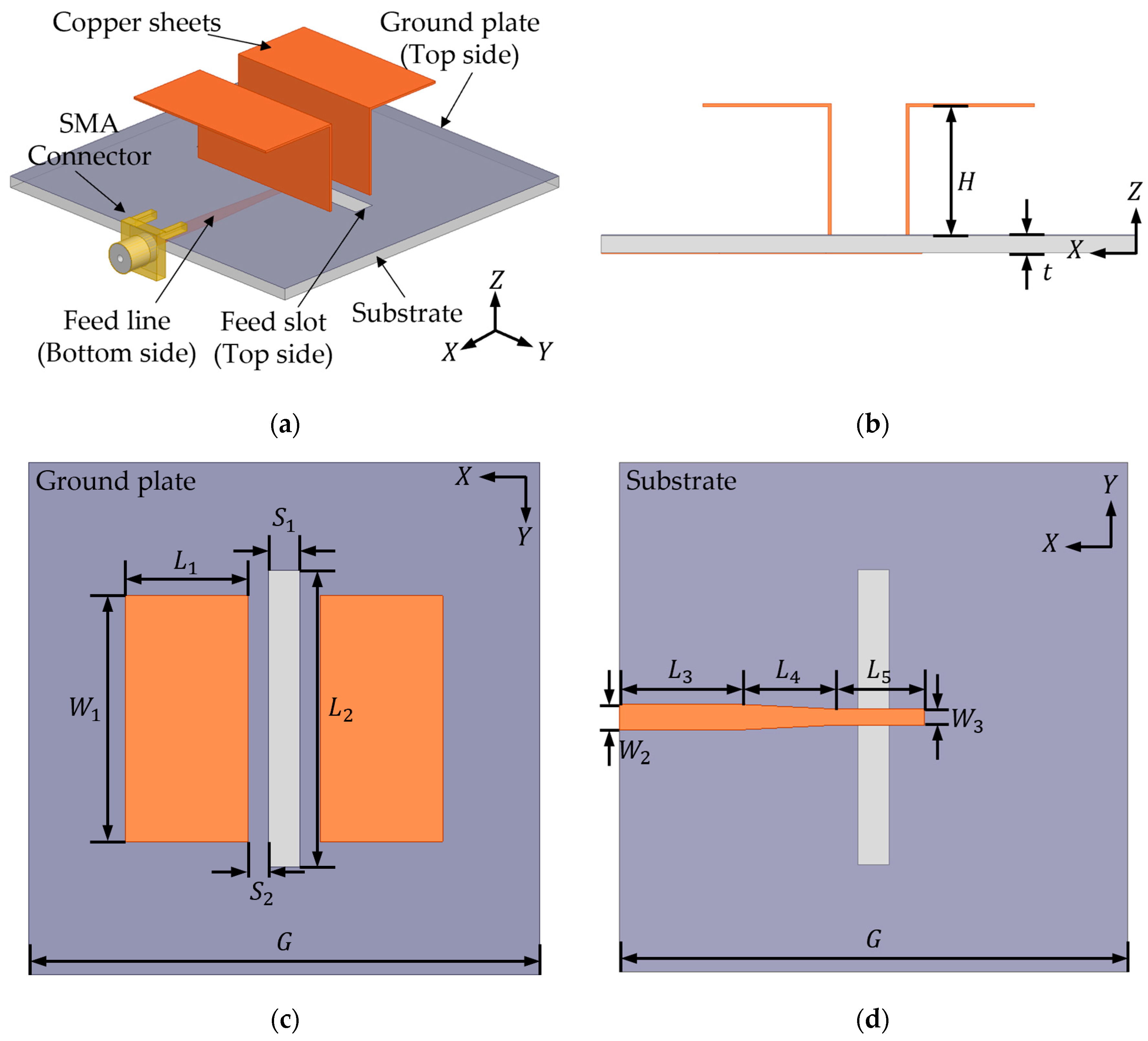
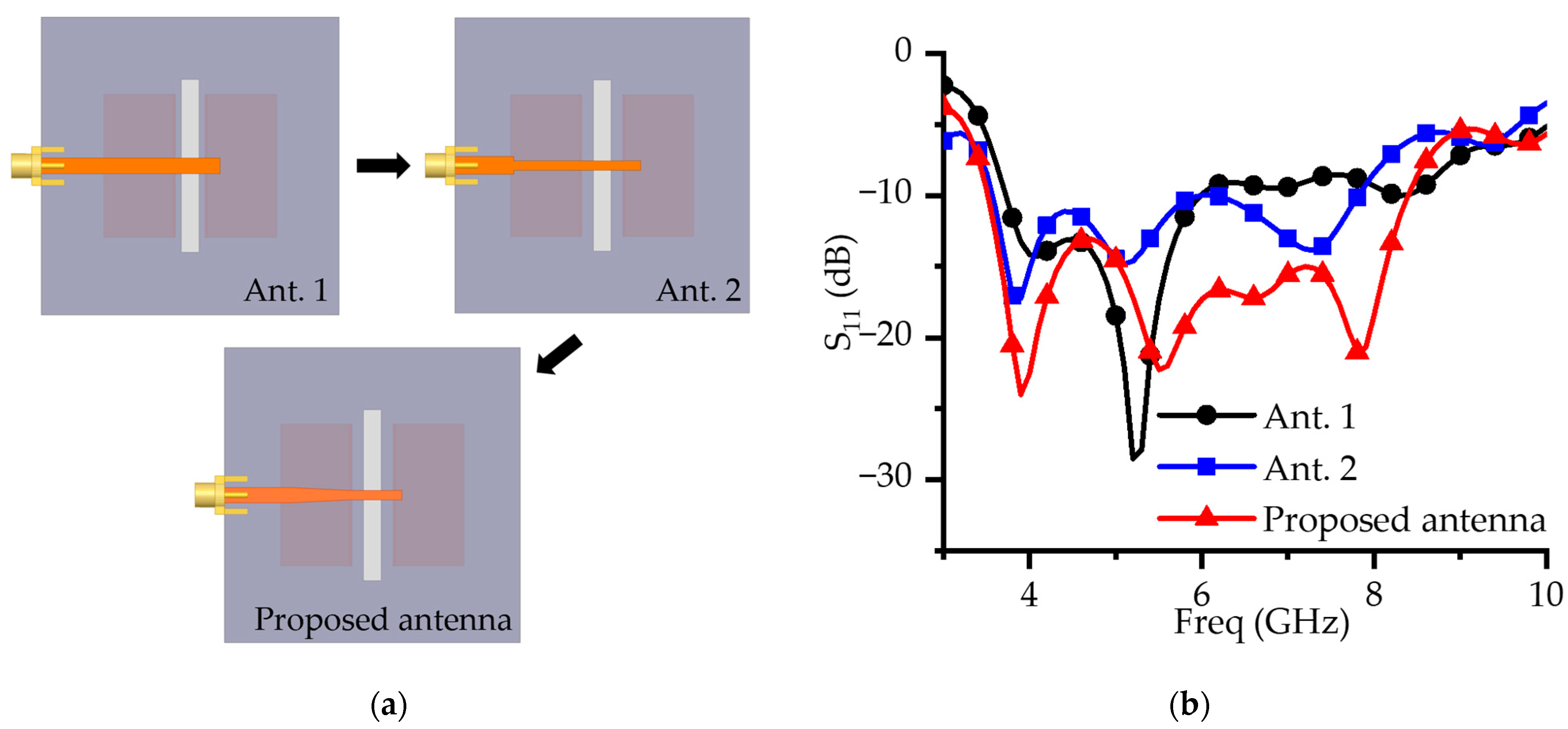


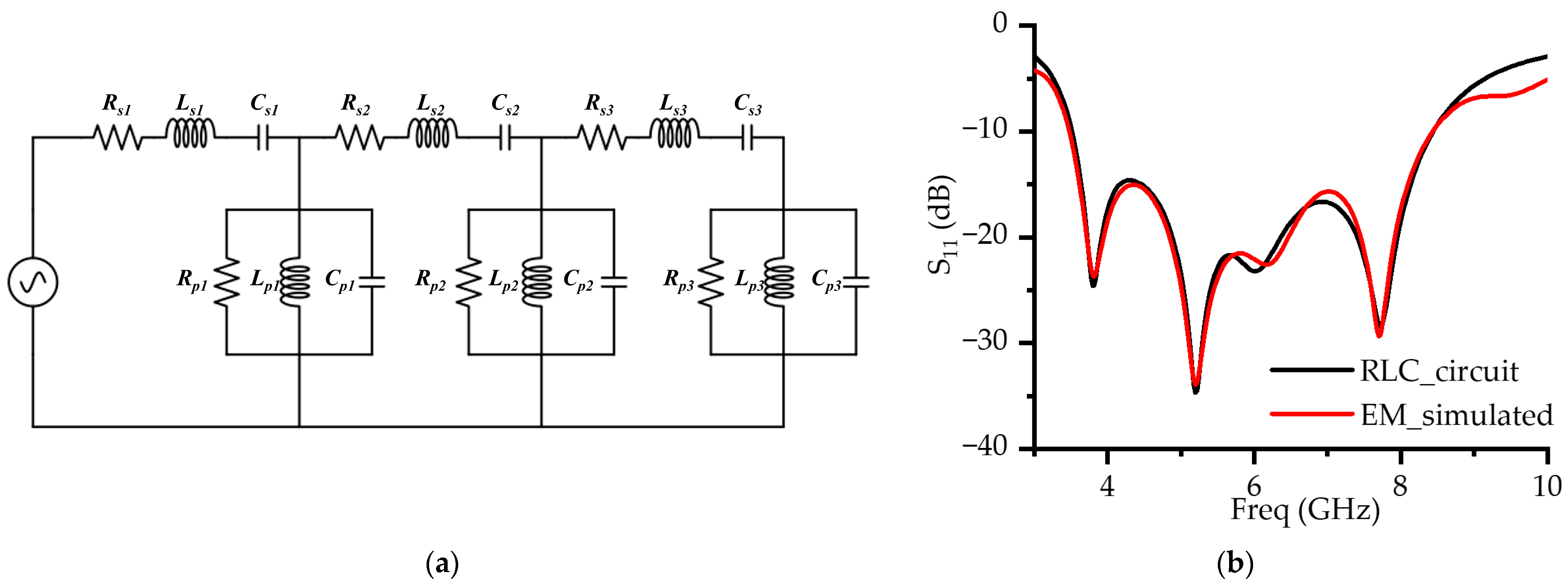

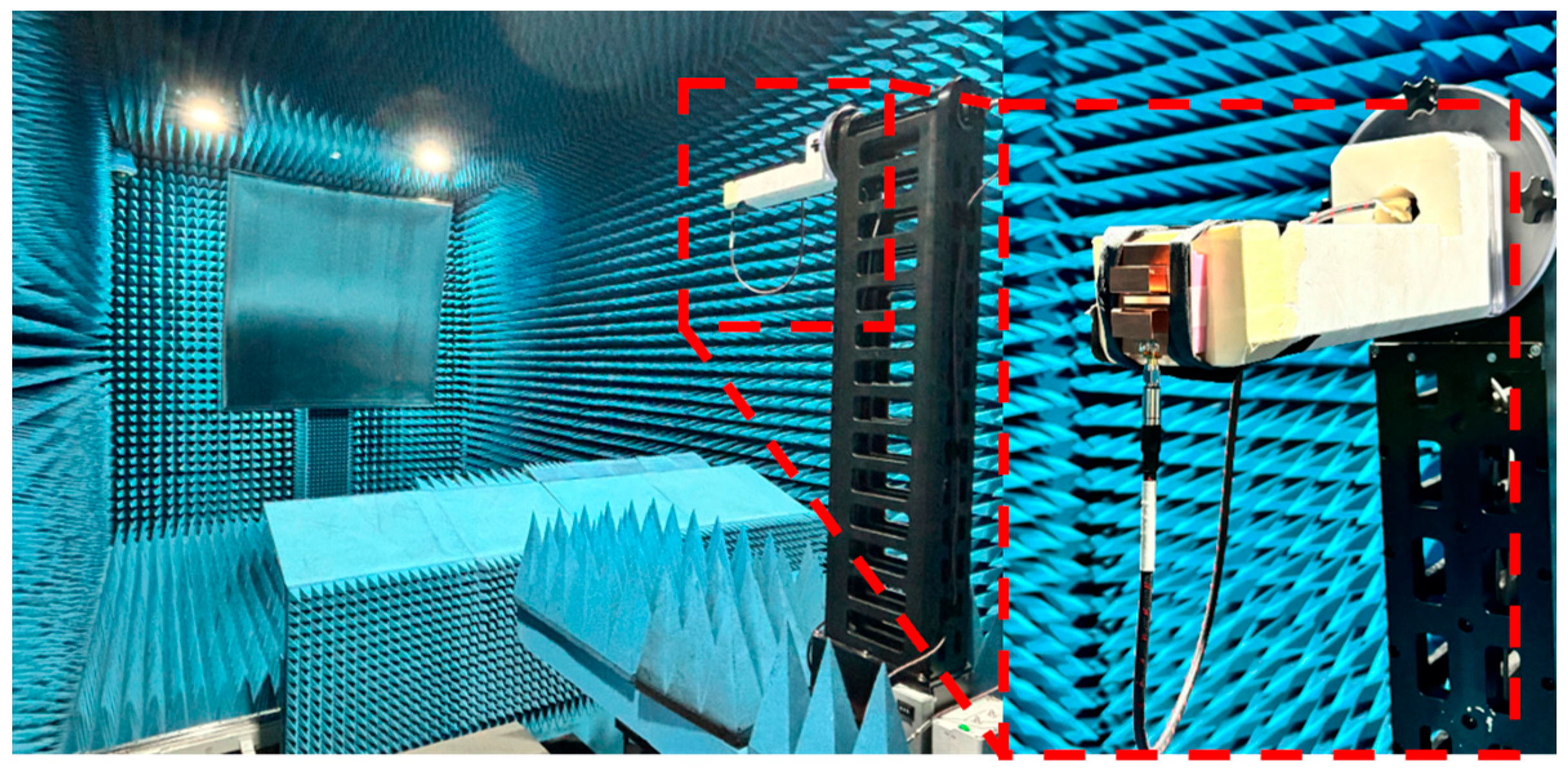
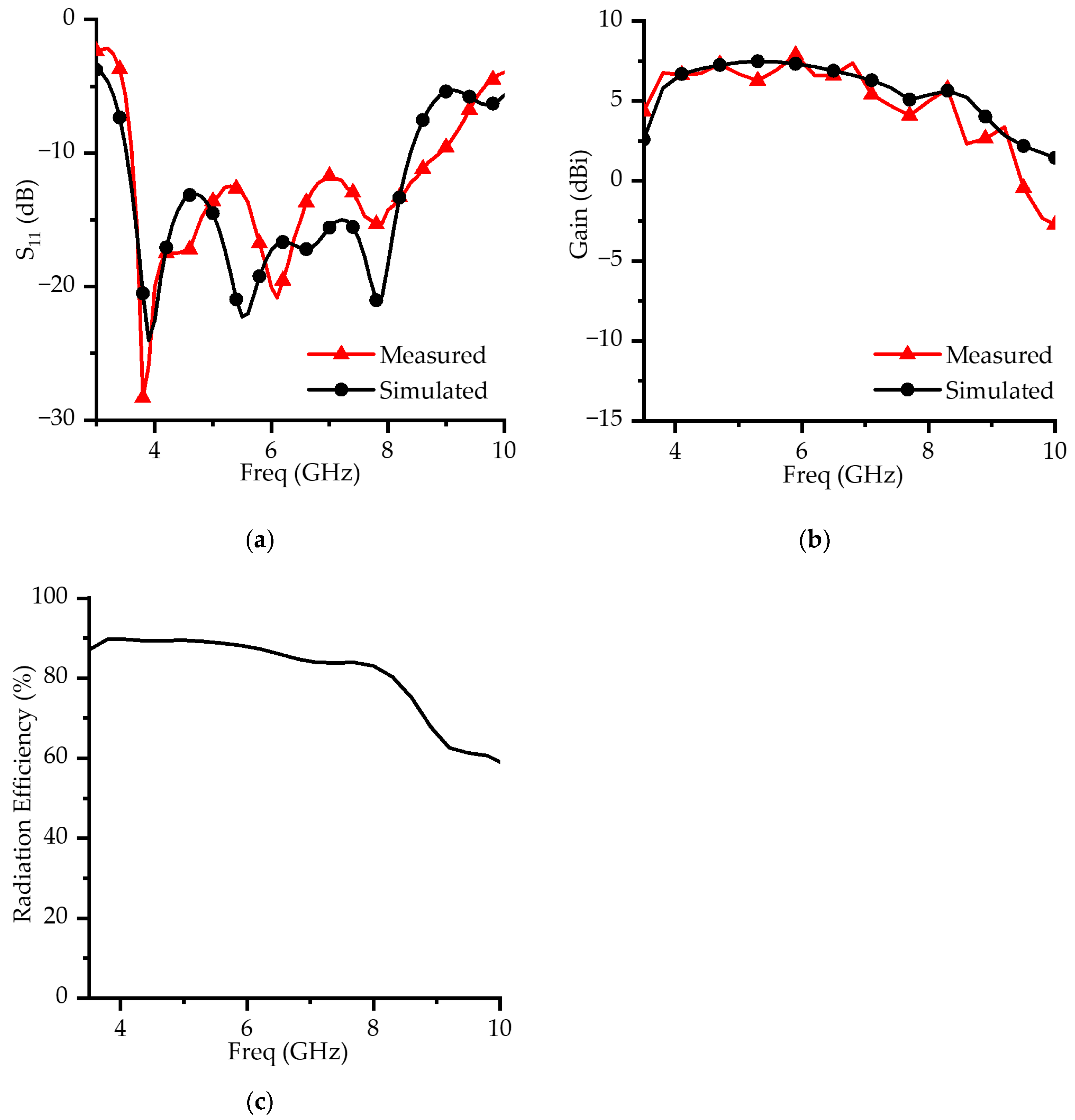
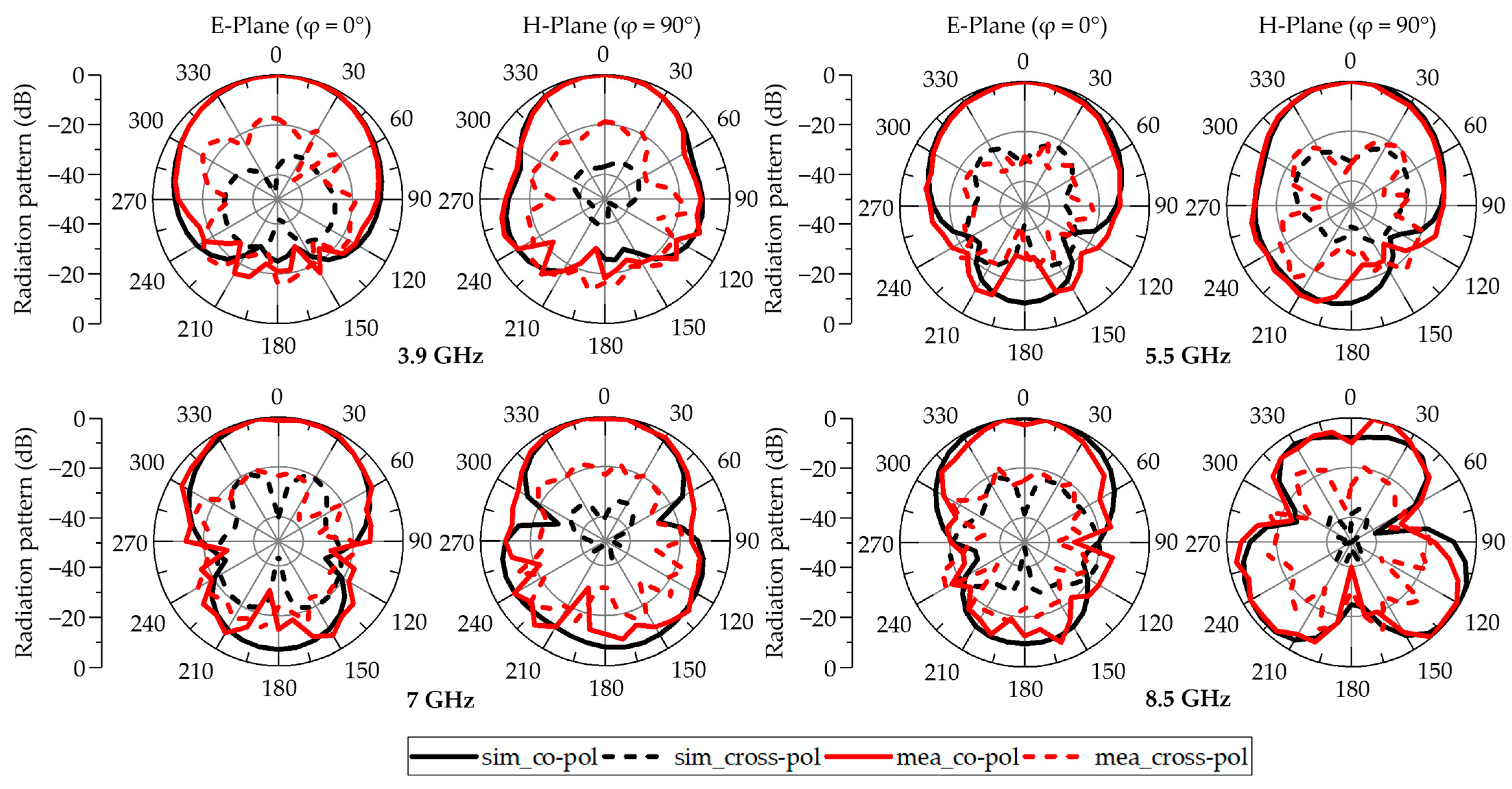
| Parameter | G | t | L1 | L2 | L3 | L4 | L5 |
| Value (mm) | 50 | 1.6 | 12 | 29 | 11 | 10 | 9 |
| * | 1 | 0.032 | 0.24 | 0.58 | 0.22 | 0.2 | 0.18 |
| Parameter | H | W1 | W2 | W3 | S1 | S2 | |
| Value (mm) | 12 | 24 | 2.6 | 1.6 | 3 | 2 | |
| * | 0.24 | 0.48 | 0.052 | 0.032 | 0.06 | 0.04 |
| Element | Value | Element | Value | Element | Value |
|---|---|---|---|---|---|
| Rs1 | 11.1 Ω | Rs2 | 24.8 Ω | Rs3 | 1 Ω |
| Ls1 | 1.43 nH | Ls2 | 1.83 nH | Ls3 | 3.9 nH |
| Cs1 | 0.58 pF | Cs2 | 0.452 pF | Cs3 | 0.935 pF |
| Rp1 | 2500 Ω | Rp2 | 24.8 Ω | Rp3 | 141.5 Ω |
| Lp1 | 0.721 nH | Lp2 | 0.158 nH | Lp3 | 3.45 nH |
| Cp1 | 1.21 pF | Co2 | 5.73 pF | Cp3 | 0.75 pF |
| Ref. | Imp.BW (GHz/%) | Peak Gain (dBi) | Size | Bandwidth Enhancement Technique |
|---|---|---|---|---|
| [14] | 2.5–6.2 (85) | 8 | 120 × 120 × 18, | / |
| [15] | 2.24–10 (125) | 7.9 | 68 × 68 × 18, | Reflector + Horn-shaped vertical structure |
| [17] | 2.35–4.27 (58) | 7.8 | 70 × 70 × 24.28, | High-permittivity stacked substrate |
| [22] | 2.35–6.14 (89.3) | 12.3 | 155 × 155 × 33.3, | Novel director loaded |
| [26] | 2.45–5.3 (73.5) | 7 | 52 × 52 × 13.6, | Liquid-dielectric resonator |
| [27] | 3.7–18 (131.8) | 6.9 | 42 × 36 × 1.6, | Balanced antipodal Vivaldi antenna (BAVA) |
| [28] | 3.1–10.6 (109) | 10 | 35 × 35 × 103, | Vivaldi antenna + Novel director loaded |
| This work | 3.61–8.89 (84.48) | 7.88 | 50 × 50 × 13.6, | / |
Disclaimer/Publisher’s Note: The statements, opinions and data contained in all publications are solely those of the individual author(s) and contributor(s) and not of MDPI and/or the editor(s). MDPI and/or the editor(s) disclaim responsibility for any injury to people or property resulting from any ideas, methods, instructions or products referred to in the content. |
© 2025 by the authors. Licensee MDPI, Basel, Switzerland. This article is an open access article distributed under the terms and conditions of the Creative Commons Attribution (CC BY) license (https://creativecommons.org/licenses/by/4.0/).
Share and Cite
Jang, H.; Park, S.; Kim, J.; Kim, K.; Lim, S. A Wideband Magneto-Electric (ME) Dipole Antenna Enabled by ME Resonance and Aperture-Coupled Excitation. Micromachines 2025, 16, 853. https://doi.org/10.3390/mi16080853
Jang H, Park S, Kim J, Kim K, Lim S. A Wideband Magneto-Electric (ME) Dipole Antenna Enabled by ME Resonance and Aperture-Coupled Excitation. Micromachines. 2025; 16(8):853. https://doi.org/10.3390/mi16080853
Chicago/Turabian StyleJang, Hyojin, Seyeon Park, Junghyeon Kim, Kyounghwan Kim, and Sungjoon Lim. 2025. "A Wideband Magneto-Electric (ME) Dipole Antenna Enabled by ME Resonance and Aperture-Coupled Excitation" Micromachines 16, no. 8: 853. https://doi.org/10.3390/mi16080853
APA StyleJang, H., Park, S., Kim, J., Kim, K., & Lim, S. (2025). A Wideband Magneto-Electric (ME) Dipole Antenna Enabled by ME Resonance and Aperture-Coupled Excitation. Micromachines, 16(8), 853. https://doi.org/10.3390/mi16080853






